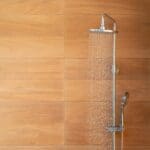Just when you thought your shower was the one place you could escape to for a bit of peace, you’ve noticed its performance isn’t what it used to be. It’s not a coincidence that the water pressure has dropped; it’s likely due to a clogged flow restrictor.
Cleaning your shower head’s flow restrictor properly isn’t just about maintaining a powerful shower; it’s also about ensuring the longevity and efficiency of your showerhead. You’ll need to start by gathering a few tools and preparing yourself for a simple, yet crucial maintenance task.
Key Takeaways
- Regularly cleaning the flow restrictor maintains shower performance and efficiency.
- Soaking the shower head in vinegar dissolves mineral deposits and improves water pressure.
- Patience and thorough rinsing are important for optimal cleaning results.
- Properly extracting and cleaning the flow restrictor prevents clogging and buildup.
Gathering Your Tools
Before you begin cleaning your shower head’s flow restrictor, gather the necessary tools such as vinegar, a bowl, a storage bag, a cloth, and toothpicks. You’re stepping into a simple yet crucial home improvement task aimed at enhancing your shower’s water pressure by removing mineral deposits and hard water build-up that often clog the flow restrictor.
If your shower head is detachable, you’ll also need to use needle-nose pliers for the removal process. This is a straightforward step but pivotal in ensuring you have full access to the flow restrictor for thorough cleaning. Do remember, handling the shower head and flow restrictor with care is paramount to prevent any accidental damage.
For those shower heads that can’t be detached, the vinegar and water solution in a storage bag becomes your go-to. This method allows you to soak the shower head without removing it, effectively dissolving the mineral deposits that are hampering water flow.
In both scenarios, patience is key. Whether you’re soaking the shower head in vinegar or meticulously using toothpicks to clear out the nooks and crannies of the flow restrictor, taking your time will yield the best results in boosting your shower’s performance.
Removing the Showerhead
To remove the showerhead, start by using an adjustable wrench to loosen it at the base of the arm. Once it’s loose, carefully unscrew it by hand from the shower arm. You’ll want to be gentle to avoid any damage.
Here’s a quick guide to follow:
- Inspect and Clean the Screen: After removal, check the shower head for a small screen or flow restrictor. Remove any large bits of debris that might be clogging it, using needle-nose pliers for precision. This step is crucial for maintaining good water flow.
- Clear Stubborn Gunk: For stubborn gunk that’s hard to reach, use a toothpick to carefully remove the screen and poke through any blockages. This will help ensure nothing is obstructing the water flow.
- Soak to Dissolve Mineral Buildup: Place the showerhead in a bag filled with a vinegar solution and secure it around the shower arm. Let it soak overnight to dissolve mineral buildup and dislodge growth.
- Reassemble and Test: After soaking, remove the bag and rinse the showerhead. Reapply plumbers tape to the threading of the shower arm for a secure fit, and screw the showerhead back on. Turn on the water to ensure everything is working correctly.
Extracting the Flow Restrictor
Having removed and cleaned the showerhead, you’ll now focus on extracting the flow restrictor to ensure optimal water pressure. This small component is crucial for controlling water flow but can become clogged with hard mineral buildup, affecting your water supply’s efficiency.
To remove the flow restrictor, first, ensure your showerhead is completely free of any loose debris or sealant tape from its threading. This preliminary cleaning helps expose the flow restrictor. Often, it’s located at the base of the showerhead, where it connects to the water supply arm. Using needle-nose pliers, gently extract the flow restrictor. Be mindful to avoid damaging it or the interior of the showerhead.
Once removed, check the flow restrictor for any large debris or mineral buildup. It’s common for these small screens to collect deposits that hinder water flow. To clean it effectively, soak both the flow restrictor and the showerhead in a solution of equal parts vinegar and water. This mixture is excellent for dissolving mineral buildup. Let them soak overnight or throughout the day for the best results. After soaking, rinse everything thoroughly under warm water before reassembling.
These cleaning tips ensure your shower head and flow restrictor are free from buildup, restoring optimal water flow to your shower.
Cleaning Process
Start by wiping down your shower head regularly to prevent buildup and maintain optimal performance.
When you notice a change in the water flow, indicating a possible mineral buildup, it’s time for a deep clean.
Here’s a straightforward cleaning process using items you likely have at home:
- Create a Cleaning Solution: Combine 1 part baking soda to 3 parts distilled white vinegar. This mixture is effective in breaking down mineral deposits.
- Prepare Your Shower Head: If possible, remove the shower head to ensure thorough cleaning. If not, don’t worry; you can still clean it effectively while attached.
- Soak the Shower Head: Pour the solution into a plastic bag. Place the shower head or flow restrictor in the bag, ensuring it’s fully submerged. Secure the bag with a rubber band and let it soak for 30 minutes to an hour. This soaking process helps remove mineral buildup.
- Scrub and Rinse: After soaking, use a bristled brush to scrub away loosened deposits. Rinse the shower head thoroughly with water to remove any remaining cleaning solution and dislodged minerals.
This cleaning process should restore the flow and performance of your shower head by effectively removing mineral buildup.
Reassembly and Testing
Once you’ve cleaned your shower head, it’s crucial to properly reassemble and test it to ensure it works efficiently.
Begin by carefully placing the flow restrictor back into its position. Ensure it sits correctly to avoid any water leakage or pressure issues.
Next, reattach the shower head to its fixture. It’s vital to screw it on securely but avoid overtightening, which could damage the threads.
After reassembly, it’s time for testing. Turn on your shower to a normal pressure setting and observe. The water should flow evenly and freely. If you notice any irregularities, recheck the assembly to ensure everything is correctly in place.
To keep your shower head running smoothly, consider regular cleaning. Here’s a pro tip: attach a bag filled with a descaling solution to the shower head, allowing the showerhead to soak overnight. This helps remove any remaining stains or mineral build-up.
Keeping the bag handy for regular use will make this process easier and prevent mineral stains from affecting your shower’s performance.
Frequently Asked Questions
Is It OK to Remove Water Restrictor From Shower Head?
It’s generally not okay to remove the water restrictor from your shower head. Doing so can mess with water pressure, waste water, and might even void your warranty. Consider cleaning it instead for better flow.
How Do You Clean a Slow Shower Head?
To clean a slow shower head, first remove it, then soak it in a heavily distilled vinegar-water solution. Use a soft toothbrush to scrub off mineral deposits. Rinse well, dry, and reattach for improved water flow.
How Do You Clean a Low Flow Shower Head?
To clean a low flow shower head, first, mix 1 part baking soda with 3 parts heavily distilled vinegar. Soak the head for 30-60 minutes, then scrub with a brush. Rinse thoroughly to improve water flow.





